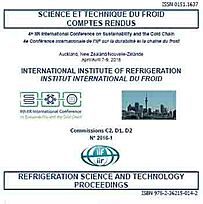
Document IIF
Améliorer l'efficacité énergétique et la qualité du lait à l'aide de systèmes frigorifiques au CO2 avec récupération de chaleur dans les exploitations laitières de Nouvelle-Zélande.
Improving the energy efficiency and milk quality with CO2 refrigeration systems with heat recovery on New Zealand dairy farms.
Auteurs : VISSER K.
Résumé
At the average New Zealand dairy farm about 6,131 litres of milk is produced daily on average from 420 cows over a 300 day period. The cows are dry for about 8-10 weeks during May to July. The warm milk from the cow is pumped into a tank with a part refrigerated wall and slowly cooled with an agitator providing movement of the milk past the cooled tank wall.
It is proposed that a small CO2 system with heat recovery produces chilled and hot water at low off peak electricity rates. Chilled water equal to 1.5 times the daily milk production is stored, as is hot water for daily CIP and general cleaning.
During milking the milk is cooled very quickly to a temperature not exceeding 7°C before it enters the storage tank. Below 7°C salmonella and E-coli do not grow. In addition to enhanced food safety, other benefits of the proposed CO2 refrigeration technology are improved product quality, reduced energy consumption and costs, and reduced direct and indirect Global Warming Emissions.
Documents disponibles
Format PDF
Pages : 8
Disponible
Prix public
20 €
Prix membre*
Gratuit
* meilleur tarif applicable selon le type d'adhésion (voir le détail des avantages des adhésions individuelles et collectives)
Détails
- Titre original : Improving the energy efficiency and milk quality with CO2 refrigeration systems with heat recovery on New Zealand dairy farms.
- Identifiant de la fiche : 30017526
- Langues : Anglais
- Source : 4th IIR International Conference on Sustainability and the Cold Chain. Proceedings: Auckland, New Zealand, April 7-9, 2016.
- Date d'édition : 07/04/2016
- DOI : http://dx.doi.org/10.18462/iir.iccc.2016.0029
Liens
Voir d'autres communications du même compte rendu (63)
Voir le compte rendu de la conférence
Indexation
-
Reduction of specific energy and carbon emissio...
- Auteurs : INDERGÅRD E., SVENDSEN E. S., UGLEM S.
- Date : 13/06/2022
- Langues : Anglais
- Source : 15th IIR-Gustav Lorentzen Conference on Natural Refrigerants (GL2022). Proceedings. Trondheim, Norway, June 13-15th 2022.
- Formats : PDF
Voir la fiche
-
Computational model of a PCM heat exchanger for...
- Auteurs : PARK J. Y., FARID M.
- Date : 07/04/2016
- Langues : Anglais
- Source : 4th IIR International Conference on Sustainability and the Cold Chain. Proceedings: Auckland, New Zealand, April 7-9, 2016.
- Formats : PDF
Voir la fiche
-
Sustainability within food cold chain sectors i...
- Auteurs : WIDELL K. N., VINGELSGARD E., DALSVÅG H., MEHTA S., NORDTVEDT T. S.
- Date : 21/08/2023
- Langues : Anglais
- Source : Proceedings of the 26th IIR International Congress of Refrigeration: Paris , France, August 21-25, 2023.
- Formats : PDF
Voir la fiche
-
Energy efficient dairy shed milk cooler and wat...
- Auteurs : REKSTAD H., HAFNER A., JENSSEN S.
- Date : 25/06/2012
- Langues : Anglais
- Source : 10th IIR-Gustav Lorentzen Conference on Natural Working Fluids (GL2012). Proceedings. Delft, The Netherlands, June 25-27, 2012.
- Formats : PDF
Voir la fiche
-
Evaluación de estrategias para minimizar las em...
- Auteurs : COCA-ORTEGON A., PRIETO J., FELIPE X., et al.
- Date : 03/05/2016
- Langues : Espagnol
- Source : CYTEF 2016. VIII Congreso Ibérico y VI Congreso Iberoamericano de las Ciencias y Técnicas del Frío, Coimbra-Portugal, 3-6 mayo, 2016.
- Formats : PDF
Voir la fiche
